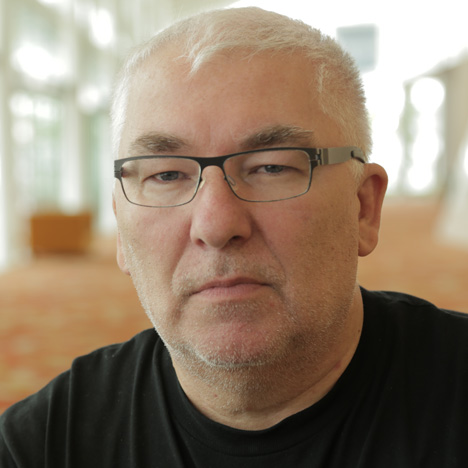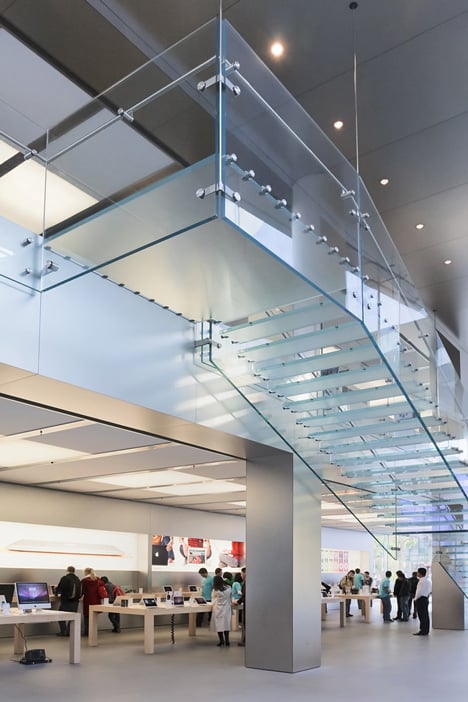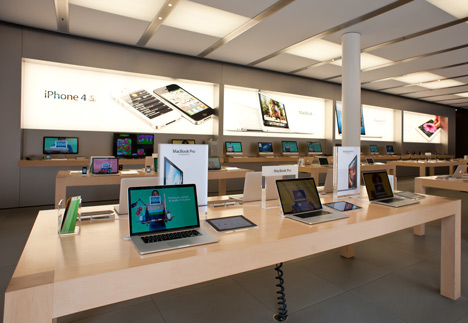
Apple's "momentum has slowed down" says Apple Store designer
News: Apple's retail presence is "not evolving as fast as it could be" and the company's "momentum has slowed down" since Steve Jobs died, according to the designer who developed the Apple Store concept with the brand's former CEO.
Tim Kobe, founder and CEO of design studio Eight Inc, made the comments at the Inside festival of interior design in Singapore today, where he took part in a seminar chaired by Dezeen editor-in-chief Marcus Fairs.
"It's not evolving as fast as it could be," said Kobe. "Since Steve [Jobs] passed away the momentum has slowed down a bit."
"It's imperative Apple shifts again. They should really refresh [their retail offering] every five years."

Kobe, who was previously based in San Francisco but who has recently relocated to Singapore, helped develop Apple's retail concept ahead of the first Apple Store openings in 2001 and has helped the company refine the stores ever since.
The spacious, minimalist stores, with signature sandstone floors and glass staircases, were unlike any other computer store when they first opened, featuring large wooden tables where customers could try out products, lecture theatres and regular events such as concerts and talks.
There are no window displays of products and, instead of a customer service counter, each features a "Genius Bar".
Kobe expanded on his thoughts on the stores in an interview with Dezeen after the seminar, which took place at the Marina Bay Sands conference centre in Singapore.
"I think that when you look at retail you have to reinvent every five years," he said. "If you're not reinventing it, you're losing your advantage."
"Steve was always very driven at staying an arms-length ahead of everyone else; that once you get ahead, you stay ahead."

"And I think many of the competitors have made rapid changes to either emulate aspects of the Apple store or to be in the market in a much bigger presence.
"I think the design is getting a little long in the tooth in terms of just continuing to roll out the same type of solution so my sense is that retail is a competitive environment, and I think Apple's ready for that next shift."
Last month Hartmut Esslinger, the industrial designer hired by Steve Jobs to help transform the brand in the 1980s, declared that Apple has lost its vision and has reached creative saturation. However strong sales of the new iPhone 5S, which was released last month to lukewarm reviews, have sent Apple shares soaring. See more Apple news »
Here's a transcript of the interview:
Marcus Fairs: Tell us about your work with Apple and Steve Jobs.
Tim Kobe: Our work with Apple has been fantastic. We were brought in as one of the major outside consultants to Apple when he first came back to the company. So we started doing launches for [the] Macworld [conferences], and the product introductions and that sort of thing, so we were already working around the brand experience for Apple.
Then I wrote a paper on retail for Steve and gave it to him. He called us one day and said hey, I want you guys to come in and start thinking about retail. We basically started with a blank whiteboard and drawing bubbles on the wall.
The programme was really a collaborative effort, there were a lot of people coming and going in the early days in terms of evolving it, in terms of building mockups and trying and exploring different things.
The basis for that collaboration has kind of evolved into a lot of the way we work [at Eight Inc] because communication and environmental designers were in that process: dealing with the behaviour of the staff; the products and services working together so that there was a seamless experience with the Apple brand. And that became a manifestation of the brand in terms of that experience.
Marcus Fairs: You showed the Fifth Avenue Apple store in your presentation earlier. What’s different about that store, and how do the Apple Stores differ from other stores?
Tim Kobe: In the very beginning, Apple had four products: two desktops and two laptops. Steve wanted a 6000sq ft space and so there were many things that we had to bring into that space besides the presentation of the product. A lot of the experiential kinds of things - presenting the product around solution-based experience, kids-based area that targeted certain markets, the Genius Bar, the theatre, there were many aspects of the overall design that were distinctive and unique to the Apple brand.
The Fifth Avenue store that we talked about, if we look at conventional rules of retail, would violate the usual checklist. It’s in a basement, there’s no product displayed in the window. It’s three streets off of the primary shopping street in New York City - or at least it used to be. The idea that it wasn't right for conventional retail wisdom but it was right for Apple - that’s what made it distinctive.
I think it was about recognising the core brand values that a company has and delivering an experience that’s aligned with that. If you can create a distinguishing opportunity - you know, distinguish the brand - if you can have the emotional connections between the brand and the customer, all of these pieces add up to something that makes something more compelling, more focused on passion versus preference in terms of relationships with the customer.

Marcus Fairs: Why did Apple decide they had to have their own branded stores?
Tim Kobe: If you look at where Apple used to sell, they had an online presence, they had the channel presence. They meant that if you were in a typical electronics distributions network, you had to express your brand in the same way that everyone talked about brands.
So people would come in and say, hey I'm interested in an Apple computer, [the sales staff would say] "It has this speed, this price etcetera, but this brand has the same features as Apple but cheaper".
So people were typically counter-selling against Apple, and when you let that channel define the game that you have in terms of presenting your brand, you're at a disadvantage. So for Apple to step out, redefine itself and really express its brand values through that experience, [they had to open their own stores].
And once that happened the traditional third-party channels were beating a path to their door. But it was really about controlling the message and drawing on the customer experience.
Marcus Fairs: Tell us about the physical design of the stores.
Tim Kobe: The physical design is probably well known. There were a number of prototype stores. [Former Gap CEO] Mickey Drexler was on the board of Apple at the time. He came from a traditional retail perspective. Steve didn't really have great experience in retail when we started the programme. But what he did have was an intuitive sense of what the Apple brand qualities were and how they could be applied.
When we tried dense presentations of the product, it didn't feel like Apple, it wasn't open enough. It wasn't accessible enough, democratic or simple enough. There were many aspects that were core values to the Apple brand, that once we were able to create more space, simplify the offering, make it more naturally about ease of use - those were all characteristics that had been a part of the Apple brand since the beginning.
[Steve] was really instrumental in making sure we were delivering that experience, strategically on brand with what the Apple qualities were.
Marcus Fairs: You said that Steve was really nervous the night before the first store opened.
Tim Kobe: Yeah, it was a little disconcerting. We had just finished the first store, working all night and setting up all the product and the lighting and adjusting everything. He was sitting on one of the tables and we were all just standing around. And he just said: "Guys, what happens if nobody comes tomorrow?" And we all sort of went, "That can't be possible".
But he was recognising that there were a lot of critics out there at the time. At the time Bloomberg [said it] was going to be a big disaster for Apple. It wasn't without a certain degree of risk and it was very visible. At that time Apple had two per cent market share. [Steve] wasn't 100% convinced that it would be as successful as it became.
That's something that speaks to the kind of the character and the vision that he has: he would take that risk, and if he felt it was right, the analytics supported it but also the intuitive aspects supported it; that it was going to be right.
And in the first year it opened we started evolving the design. It started to change and continue to evolve. Learning from experience with the people and the retail, it was something that we could continue to refine and make better and better.
Marcus Fairs: You said in the talk earlier that you feel the pace of renewal has slowed down a bit at Apple. With retail you can't stay still, you need to reinvent every five years, and since Steve died, the pace of change has slowed a bit.
Tim Kobe: Yeah, yeah. I think that when you look at retail you have to reinvent every five years, if you're not reinventing it, you're losing your advantage. Steve was always very driven at staying an arms-length ahead of everyone else; that once you get ahead, you stay ahead. And I think many of the competitors have made rapid changes to either emulate aspects of the Apple store or to be in the market in a much bigger presence.
I think the design is getting a little long in the tooth in terms of just continuing to roll out the same type of solution so my sense is that retail is a competitive environment, and I think Apple's ready for that next shift.
Apple Store interior photos courtesy of Shutterstock.